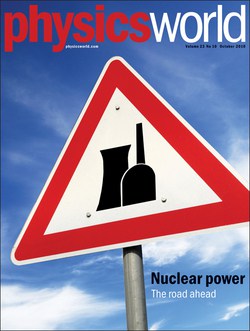By Louise Mayor
Until recently, the phrase “nuclear power” conjured for me a hazy and somewhat ignorant vision, comprising images of cooling towers, diagrams of fission and a sense of subdued controversy, in which proponents from neither the pro- nor anti-nuclear lobbies seem to know more about the subject that I do from high-school days.
But for the past few months I have been immersed in the landscape of modern nuclear power in preparation for a special issue of Physics World, which should land on readers’ doorsteps any day now. It is also available as a free PDF download.
Something I really wanted to get to grips with, when it comes to nuclear power, is who has what, and where? Well, if you do too, check out our colour-coded nuclear power world map, based on data from the International Atomic Energy Agency. It’s on pages 38 and 39 of the “special issue”.
But where do we go from here? In the long term, newly built reactors could be based on the six designs that the Generation-IV International Forum – consisting of 13 Members including the Russian Federation, the US, China and the UK – identified to meet its goals. Physics World’s Rome correspondent Edwin Cartlidge writes about these in the feature “Nuclear’s new generation”.
We also review four concepts for radically different reactor designs, including the travelling-wave reactor endorsed by Bill Gates; and accelerator-driven sub-critical reactors, which we quiz Nobel-prize-winning physicist Carlo Rubbia about in a Q&A.
Not only are there new designs, but new fuel. Elsewhere in the special issue, award-winning science writer Matthew Chalmers looks at how India is seeking to exploit its vast reserves of thorium as an alternative to uranium.
As well as fission, nuclear power also covers the realm of fusion. In the feature “Hot fusion”, Steve Cowley, chief executive of the UK’s Atomic Energy Authority, looks at the challenges facing the ITER facility being built in southern France. He says that with predictions of net power gain at ITER, we should act now to reduce the time to commercial fusion.
Attitudes are key in an energy future with nuclear power in the mix – a future that is only feasible if it has support. With that in mind, check out the debate between climate scientists who go head to head on the merits of nuclear power. You’ll find this, and much more, in the October issue of Physics World.




